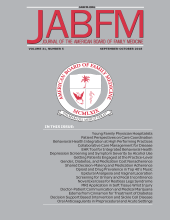Abstract
Background: By the age of 60 years, an estimated 33% of women will have undergone a hysterectomy. Approximately 85% of these hysterectomies are performed for benign disease. The object of this study was to evaluate cytologic findings from vaginal cuff smears in patients who have undergone hysterectomy for benign uterine conditions.
Methods: We conducted a community-based retrospective study and foilow-up of women with vaginal cuff cytologic smears who had had a hysterectomy for benign uterine conditions. A total of 220 women were randomly selected who had one or more vaginal cuff smears. The main outcomes measures were invasive carcinoma, dysplastic lesions, and infections detected by vaginal cuff smear testing. The setting was a large inner-city hospital.
Results: Ninety-seven percent of 220 women who underwent hysterectomy for benign uterine conditions and who were observed for an average of 89 months had no cytologic abnormalities on vaginal cuff smears. Cytologic evaluation found no invasive carcinomas. Dysplastic lesions were detected in 7 patients (3%). Seventy percent of patients (n = 154) had one or more infections; these infections included bacterial vaginosis (106), trichomoniasis (95), candidiasis (40), koilocytosis suggestive of human papilloma virus (HPV) infection (3), and cytopathic effect of herpes (4). The prevalence of koilocytosis was much higher in the patients with dysplasia (P = .0003).
Conclusions: Most routine vaginal cuff cytology screening tests need not be performed in women who have had a hysterectomy for benign uterine conditions.






